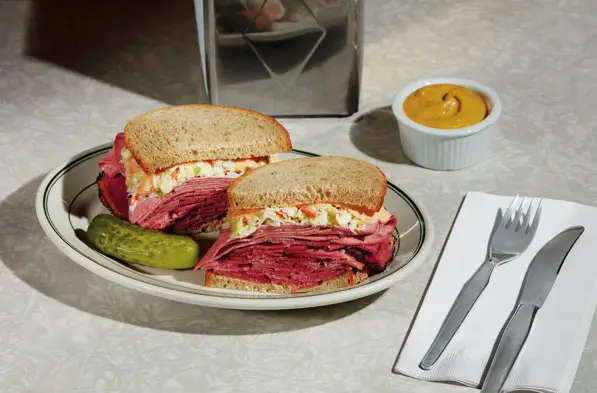When eating out with the family, finding something on the menu for everyone may be a challenge, especially if someone is gluten-free. Kim Koeller and Robert La France, authors of Let’s Eat Out Around the World Gluten Free and Allergy Free, share the questions to ask to avoid gluten at any restaurant. Plus, international travel tips for eating gluten-free.

One of the most popular alternative treatments for autism is a gluten-free, casein-free diet (GFCF). This strict elimination diet has not been scientifically proven to work, and we are not advocating it; please check with your physician about the merits and risks of putting your child on such a regimen.
If a family member is gluten-free or has food allergies, eating outside your home is no picnic. Finding safe foods at restaurants or even at a friend’s home becomes a complicated, frustrating, and sometimes scary process when you’re trying to maintain a strict diet free of gluten or any commonly used ingredient. Throw in travel, which requires eating on-the-go and dining in not-so-familiar settings, and you may be tempted to skip your next family vacation—or any vacation, for that matter.
But it doesn’t have to be that way. Armed with the right knowledge and with some smart planning, you and your special eater can comfortably venture outside your home and enjoy eating experiences around the world (or even just in the restaurant down the street because, hey, you’re sick of cooking!).
Following is a list of ingredients and preparation techniques that may be of concern to those managing celiac disease or other food sensitivities. The list was compiled by Kim Koeller, creator of the award-winning Let’s Eat Out! series of books, e-books, and mobile apps, who suffers from celiac disease as well as several food allergies and has been living gluten- and allergy-free for the past decade. Koeller partnered with Robert La France, a restaurant industry veteran, and together the two analyzed common restaurant ingredients from both behind and outside the kitchen door.
“My world began to open back up again,” Koeller recalls of when she started working with La France. “I started thinking that I could safely and confidently eat out like a normal person—just with special dietary considerations. Feeling empowered to live and enjoy myself while being diligent with foods anywhere in the world is truly incredible.”
A Word on Gluten
Gluten is the protein found in wheat, rye, and barley. It is a composite name representing gliadin in wheat, hordein in barley, and secalin in rye. Gluten can also be the name given for avenin, a slightly different protein found in oats. It should be noted that oats without measurable contamination from wheat, rye, and barley may be referred to as certified gluten-free oats in some parts of the world. Individuals who experience a reaction to pure uncontaminated oats are reacting to the oat avenin.
Individuals can also have allergies, intolerances, or sensitivities to wheat without having the dietary concerns for other grains that contain gluten.
|
Tips & Tools International Travel Tips for Individuals with Food Allergies When venturing overseas, following these travel guidelines will help to increase your comfort level while staying in both English and foreign-language speaking destinations. • Contact the local celiac or food allergy associations for suggestions on eating gluten- and allergen-free in that specific country. For those visiting foreign-speaking countries, it is important to communicate your needs in the native language. • Ensure any medical documentation that may be needed has been translated into the language of each country included in your travels. |
What to Watch For When Eating Gluten-Free
Gluten, wheat, and their derivatives can be used in the most unlikely places. This list will arm you with the knowledge you need to avoid potentially dangerous ingredients for those with celiac disease or gluten and wheat allergies or sensitivities.
Artificial bacon bits are used as substitutes for bacon primarily in North America and may contain gluten/wheat, corn, and soy, as well as other ingredients. They are typically offered with baked potatoes and in salads.
Sample question: “Is the bacon included in the baked potato real or artificial?”
Artificial mashed potato mix is often used as a time-saving and inexpensive solution for mashed potatoes in North America and may contain gluten/wheat, corn, dairy, peanuts, and soy.
Sample question: “Are the mashed potatoes with this dish real or artificial?”
Batter typically contains gluten/wheat or corn flour combined with eggs and is used in many types of international cuisines.
Sample question: “Is the calamari battered with wheat flour?”
Beans may include wheat flour as an ingredient in many international cuisines.
Sample question: “Do the fava beans contain wheat flour as prepared?”
Bouillon is often used as a time-saving, inexpensive solution for soup bases and sauces. It often contains gluten/wheat, corn, and soy, as well as other ingredients.
Sample question: “Is this soup made with fresh vegetable broth or bouillon?”
Bread or breadcrumbs typically contain gluten/wheat, corn, dairy, eggs, peanuts, soy, and tree nuts, as well as other ingredients, and are used in many types of international cuisines.
Sample question: “Are the escargots (snails) topped with bread crumbs?”
Breading typically contains gluten/wheat, corn, dairy, eggs, and soy and is used in many international cuisines.
Sample question: “Is the petti di pollo (Italian chicken breast) breaded?”
Cake, cookies, or biscuits can contain gluten/wheat, dairy, eggs, peanuts, soy, and tree nuts. They are included as ingredients or accompaniments to desserts in many international cuisines.
Sample question: “Is there any gluten/wheat in the flourless chocolate torte?”
Clean water is a request that may be necessary to eliminate the possibility of cross-contact from preparing other menu items such as pasta.
Sample question: “Is your rice cooked in the same water as your pasta?”
Colors or flavors can be made from a variety of ingredients, some of which contain gluten/wheat, corn, dairy, eggs, peanuts, soy, and tree nuts. These may be included in pre-fabricated frozen desserts, beverages, and food coloring.
Sample question: “Is the smoked sausage made in the restaurant or do you use pre-packaged sausage that identifies gluten/wheat or its derivatives on the label?”
Croutons typically contain gluten/wheat, corn, dairy, eggs, peanuts, soy, and tree nuts, as well as other ingredients.
Sample question: “Is the salad (or soup) topped with croutons?”
“Dedicated fryer” is a term used for a fryer that only fries one particular food type (e.g. battered items only). Dedicated fryers eliminate the possibility of gluten/wheat cross-contact from frying battered, breaded, or gluten/wheat–flour-dusted foods with non-gluten containing foods.
Sample question: “Are your French fried potatoes/chips fried in the same fryer as your beer-battered onion rings?”
“Fluffing agent” is a term used for adding an ingredient, such as gluten/wheat, to eggs to enhance their appearance and increase their volume.
Sample question: “Do you add gluten/wheat to the egg mix for your omelets?”
Garnishes containing gluten/wheat, peanuts, and tree nuts are common in international cuisines.
Sample question: “Is this salad garnished with a breadstick?”
Imitation crabmeat or seafood, also known as surimi, is commonly used in Asian cuisines. It is made of fish paste and additives and then molded into a shape, usually resembling crabmeat. In addition to fish, surimi typically contains gluten/wheat and may contain corn, eggs, and soy.
Sample question: “Do you use imitation crabmeat in your seafood bisque?”
Malt is typically made from barley or corn. Barley contains gluten and is commonly used in commercially produced beverages, confectionery products, and frozen desserts.
Sample question: “Does the ice cream container identify malt or barley as an ingredient on the label?”
Malt vinegar is made by fermenting barley, which contains gluten, and is not distilled. It is a common condiment in French cuisine and also used regularly in the United Kingdom.
Sample question: “Can you hold the malt vinegar with my French fried potatoes order?”
Marinades may have packaged seasonings which contain gluten/wheat as an ingredient.
Sample question: “Does the marinade for gai yang (Thai BBQ chicken) contain gluten?”
Noodles or pasta may contain gluten/wheat and eggs as ingredients.
Sample question: “Are the noodles in the pad see yu made with gluten/wheat?”
Oil is used to cook many gluten-containing items. Ensure fresh cooking oil is used to eliminate the possibility of cross-contact from cooking other menu items.
Sample question: “Can you use fresh oil to fry my huevos Mexicanos (Mexican eggs)?”
Salad dressing that is commercially produced may contain ingredients derived from gluten/wheat, corn, dairy, eggs, fish, and soy.
Sample question: “Does the ranch dressing identify gluten/wheat or its derivatives as an ingredient on the label?”
Sauce may contain gluten/wheat as an ingredient, as well as corn, dairy, eggs, peanuts, soy, and tree nuts. Commercially produced sauces may contain a number of different gluten/wheat derivatives.
Sample question: “Does the peanut sauce contain gluten/wheat?”
Seasonings that are commercially produced sometimes contain ingredients derived from gluten/wheat, corn, dairy, and soy.
Sample question: “What type of seasonings do you use to flavor the French fried potatoes?”
Soy sauce is a common ingredient in Asian and other international cuisines. In addition to being made from soy, most soy sauces also contain gluten/wheat as an ingredient. Soy sauce is used in marinades, as an accompanying condiment, or as an ingredient in sauces and soups.
Sample question: “Is there soy sauce in the lemon chicken?”
Stabilizers containing gluten/wheat or dairy/whey may be used in commercially produced frozen desserts.
Sample question: “Does the sorbet container identify gluten/wheat stabilizers as an ingredient on the label?”
A thickening agent is an ingredient such as gluten/wheat added to soups or sauces so they have a higher viscosity or thickness.
Sample question: “Do you use gluten/wheat to thicken the broth of the egg drop soup?”
Tortillas or tortilla chips may contain gluten/wheat, corn, or soy and are common in Central and South American cuisines. They can be made from either corn or wheat flour and lard or vegetable oil containing corn and soy.
Sample question: “Can I have corn tortillas with my carnitas (Mexican simmered pork)?”
Wheat flour can be used as an ingredient in the most unlikely places. Non-traditional food preparation techniques involving wheat flour are indicated throughout this article.
Sample question: “Do you add wheat flour to your hollandaise sauce?”
Wheat flour dusting is often used for coating meat or fish with an ingredient, such as gluten/wheat, for texture prior to pan-frying.
Sample question: “Do you dust the beef in gluten/wheat prior to pan frying?”
This article was excerpted with permission from the fourth edition of Let’s Eat Out Around the World Gluten Free and Allergy Free by Kim Koeller and Robert La France (Demos Health Publishing, 2013), a first-of-its-kind how-to guide designed to provide an in-depth understanding about cooking, eating out, and traveling with special dietary requirements.





















